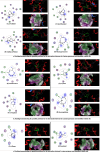Comparative chemical and antimicrobial evaluation of the essential oils from Callistemon and podocarpus species supported by in-silico molecular simulations against bacterial LacY protease
- PMID: 40259304
- PMCID: PMC12012950
- DOI: 10.1186/s12906-025-04826-w
Comparative chemical and antimicrobial evaluation of the essential oils from Callistemon and podocarpus species supported by in-silico molecular simulations against bacterial LacY protease
Abstract
Background: Myrtaceae and Podocarpaceae botanical families include several aromatic species that have been proven to have diverse pharmacological potential, especially antimicrobial effects. Additionally, plants of both families were reported for their benefits in traditional medicine. The current study demonstrated the chemical profile, antimicrobial of four investigated plant species (C. subulatus, C. rigidus, P. gracilior, and P. elongatus) leaves cultivated in the same place in Egypt and propose in-silico modeling for the antibacterial mechanistic action.
Method: The essential oils samples were prepared via hydrodistillation and headspace extraction protocol and GC analysis was conducted to obtain a comparative chemical profile. The antimicrobial activity of the obtained hydrodistillation essential oil samples was screened via agar diffusion, and the MIC was calculated via broth microdilution assays. An in silico molecular docking study was performed to investigate the inhibition of the LacY protease efflux pump.
Results: GC results revealed that the percentage of oxygenated monoterpenes was highest in the oil samples from Callistemon species (60.38 and 82.68%). In contrast, sesquiterpene hydrocarbons constituted the highest percentage of volatile classes in the oil samples from Podocarpus species (57.37 and 43.16%). C. rigidus-EO shows significant inhibitory activity against Gram-negative and Gram-positive pathogens, especially E. coli and S. viridans, with a calculated MIC of 0.878 ml, whereas P. elongatus EO shows notable activity against coagulase-negative Staphylococcus and the activity was comparable to that of the positive control antibiotics used (ciprofloxacin & doxycycline). Ultimately, an in silico molecular docking study on the binding site of the LacY protease enzyme revealed a significant binding affinity of the major docked volatile constituents.
Conclusion: The plant species investigated are considered a vital source of safe antimicrobial volatile constituents that are recommended as bioactive entities for controlling microbial infection topically or systemically. The proposed mechanistic action encourages further modification of the major EOs chemical structure by adding more polar substitutions to improve the binding affinity and produce more active semisynthetic analogues.
Keywords: Antimicrobial; Efflux pump; Essential oil; Lactose permease; Molecular docking.
© 2025. The Author(s).
Conflict of interest statement
Declarations. Ethics approval and consent to participate: The study was conducted according to the relevant guidelines of the Ethics Committee at Ahram Canadian University, which approved the study with number REC0824. Experimental research and field studies on plants. We confirm that all methods were performed in accordance with the relevant guidelines and regulations and complied with relevant institutional, national, and international guidelines and legislation. Consent for publication: Not applicable. Competing interests: The authors declare no competing interests.
Figures

Similar articles
-
Chemical and biological characterization of Melaleuca subulata (Cheel) Craven leaves' volatile constituents supported by chemometric analysis and molecular docking.BMC Complement Med Ther. 2024 Feb 5;24(1):76. doi: 10.1186/s12906-024-04345-0. BMC Complement Med Ther. 2024. PMID: 38317130 Free PMC article.
-
Phytochemical profile and antimicrobial activity of essential oils from two Syzygium species against selected oral pathogens.BMC Complement Med Ther. 2023 Dec 12;23(1):448. doi: 10.1186/s12906-023-04277-1. BMC Complement Med Ther. 2023. PMID: 38087292 Free PMC article.
-
Phytochemical profiling and seasonal variation of essential oils of three Callistemon species cultivated in Egypt.PLoS One. 2019 Jul 11;14(7):e0219571. doi: 10.1371/journal.pone.0219571. eCollection 2019. PLoS One. 2019. PMID: 31295290 Free PMC article.
-
Chemical Composition, Enantiomeric Distribution, Antimicrobial and Antioxidant Activities of Origanum majorana L. Essential Oil from Nepal.Molecules. 2022 Sep 19;27(18):6136. doi: 10.3390/molecules27186136. Molecules. 2022. PMID: 36144869 Free PMC article. Review.
-
Essential Oils of Neotropical Myrtaceae Species From 2011 Until 2023: An Update.Chem Biodivers. 2025 Feb;22(2):e202401503. doi: 10.1002/cbdv.202401503. Epub 2024 Nov 12. Chem Biodivers. 2025. PMID: 39322619 Review.
References
-
- Anjali, Kumar S, Korra T, Thakur R, Arutselvan R, Kashyap AS, Nehela Y, Chaplygin V, Minkina T, Keswani C. Role of plant secondary metabolites in defence and transcriptional regulation in response to biotic stress. Plant Stress. 2023;8:100154.
-
- Panizzi L, Flamini G, Cioni PL, Morelli I. Composition and antimicrobial properties of essential oils of four Mediterranean Lamiaceae. J Ethnopharmacol. 1993;39(3):167–70. - PubMed
-
- Moghaddam M, Mehdizadeh L: Chapter 13 - Chemistry of essential oils and factors influencing their constituents. In: Soft Chemistry and Food Fermentation. edn. Edited by Grumezescu AM, Holban AM: Academic Press, Cambridge, Massachusetts; 2017:379–419.
-
- Hamid A, Aiyelaagbe O, Usman L. Essential oils: Its medicinal and pharmacological uses. Int J Curr Res. 2011;33:86–98.
-
- Buchbauer GJP. flavorist: The detailed analysis of essential oils leads to the understanding of their properties. Perfumer and flavorist. 2000;25:64–7.
Publication types
MeSH terms
Substances
LinkOut - more resources
Full Text Sources
Medical
Miscellaneous

